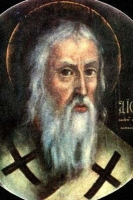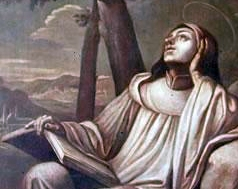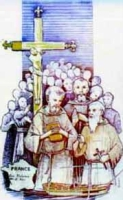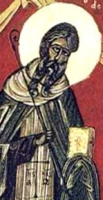Saint Theodore Guerin
புனித மதர் தியோடர் குரீன் (சபைத் தலைவர்)
நினைவுத்திருவிழா : அக்டோபர் 03
பிறப்பு : 1798 பிரான்ஸ்
இறப்பு : 14 மே 1856 அமெரிக்கா
முத்திபேறுபட்டம் : அக்டோபர் 1998
திருத்தந்தை 2 ஆம் அருள் சின்னப்பர்
புனிதர்பட்டம் : 15 அக்டோபர் 2006
திருத்தந்தை 16 ஆம் பெனடிக்ட்
புனித மதர் தியோடர் குரீன், "புனித மேரி ஆஃப் வூட்ஸ்" (Saint Mary of Woods) என்ற சபையை நிறுவினார்.
இவர் நல்லொழுக்கத்தால், மற்றவர்களுக்கு சிறந்த எடுத்துக்காட்டாக இருந்தார். நம்பிக்கையின் மறு உருவமாக திகழ்ந்தார். இவர் தனது செப வாழ்வினால் மிகவும் வலிமைப் பெற்று வாழ்ந்தார். தனது எளிமையான வாழ்வால், இவ்வுலக துன்பங்களை எதிர்த்தார். ஏராளமான துன்பங்களை பொறுமையுடன் ஏற்றார். அமைதியின் சிகரமாய் இருந்தார்.
இவர் 1825 ஆம் ஆண்டு, செப்டம்பர் 8 ஆம் நாள் துறவியானார். 1840-1856 ஆம் ஆண்டு வரை "புனித வூட்ஸ் மேரி" (Sisters of Providence of Saint Mary of the Woods) என்ற சபையை நிறுவி, அச்சபையின் தலைவியாக பொறுப்பேற்றார். சபையை நிறுவி, பொறுப்பேற்ற நாளிலிருந்து, தன்னை இறைவனிடம் கையளித்து, இறைவன் மட்டுமே சபையை வழிநடத்த வேண்டுமென்று இடைவிடாமல் செபித்தார். இறைவனின் வழிநடத்துதலாலும், பராமரிப்பினாலும் பல வழிகளில், பலமுறை வெற்றியும் கண்டார்.
Also known as
• Mother Theodore
• Anne-Thérèse Guérin
Profile
Daughter of Laurent and Isabelle Guérin. Joined the Sisters of Providence at Ruillé-sur-Loir, France on 18 August 1823, taking the name Sister Saint Theodore, and making her final vows on 5 September 1831. Taught in Rennes and Soulaines, France. Sent with five other sisters (Sister Olympiade Boyer, Sister Saint Vincent Ferrer Gagé, Sister Basilide Sénéschal, Sister Mary Xavier Lerée and Sister Mary Liguori Tiercin) to the diocese of Vincennes, Indiana, USA on 22 October 1840. They established the Academy of Saint Mary-of-the-Woods on 4 July 1841 at Terre Haute, Indiana, the first Catholic women's liberal-arts college in the United States. She established schools at Jasper, Saint Mary-of-the-Woods Village, Vincennes, Montgomery, Madison, Terre Haute, Fort Wayne, Evansville, North Madison, Lanesville and Columbus, all in Indiana, and Saint Francisville in Illinois. Founded an orphanage for girls and one for boys in Vincennes, Indiana. Opened pharmacies where medicines were dispensed free to the poor at Vincennes and Saint Mary-of-the-Woods, Indiana. Oversaw construction of a motherhouse for the Sisters of Providence and several additions to the Academy.
Born
2 October 1798 at Etables-sur-Mer, Brittany, France as Anne-Thérèse Guérin
Died
• 14 May 1856 at Saint Mary-of-the-Woods, Indiana, USA, of natural causes
• buried at Church of the Immaculate Conception, Saint Mary-of-the-Woods
Canonized
15 October 2006 by Pope Benedict XVI
Patronage
Lafayette, Indiana, diocese of
Blessed Jesús Emilio Jaramillo Monsalve
Profile
The son of Alberto Jaramillo, a craftsman, and Cecilia Monsalve, a housewife, Jesús was baptized at the age of one day. In the minor seminary, he joined the Misioneros Javerianos de Yarumal (Xaverian Missionaries of Yarumal). Ordained a priest on 1 September 1940. He served as parish priest in Sabanalarga, Colombia, and as chaplain and spiritual advisor at a women's prison. Spiritual director of seminarians and novice master of the Misioneros in 1945. He taught dogmatic theology, Sacred Scripture, Hebrew and Greek in the seminary. Rector of seminarians from 1951 to 1959. Superior-general of the Misioneros from 1959 to 1966. Appointed Vicar Apostolic of Arauca, Colombia and Titular Bishop of Strumnitza by Pope Paul VI on 11 November 1970. Chosen Bishop of Arauca, Colombia by Pope John Paul II on 19 July 1984. Father Jesús spoke out against the teachings and atrocities of the Communist rebel group E.L.N., which led to his being kidnapped on 2 October 1989 while making pastoral visits, tortured and abused for a day or so, and then murdered. Martyr.
Born
16 February 1916 in Santo Domingo, Antioquia, Colombia
Died
shot twice in the head on 3 October 1989 near Fortul, Arauca, Colombia
Beatified
• 8 September 2017 by Pope Francis
• the beatification recognition was celebrated at the Parque Temático Las Malocas, Villavicencio, Meta, Colombia with Pope Francis as chief celebrant
Blessed Szilárd István Bogdánffy
Profile
Son of teachers. Studied philosophy and theology at Peter Pazmany University of Budapest, Hungary. Ordained on 29 June 1934, and assigned to the Saint Therese of Lisieux parish in Oradea (in modern Romania). Taught in Satu Mare and the seminary in Oradea. Bishop of Satu Mare, Romania on 14 February 1949; due to the Communist persecution of the Church, he was consecrated clandestinely. Arrested on 5 April 1949 for treason and other charges, all a result of his being a leader of the Church. Following a show trial, he was sentenced to 12 years foced labour in a lead mine. After transfer to several prison camps, where he was noted to ministering to other prisoners, abused, tortured and neglected, he finally died in the prison in Nagyenyed, Romania. Martyr.
Born
21 February 1911 in Crna Bara, Coka, Hungary (in modern Serbia)
Died
3 October 1953 in Nagyenyed (Aiud), Alba, Romania of pneumonia
Beatified
• 30 October 2010 by Pope Benedict XVI
• beatification recognition presided over by Cardinal Peter Erdo, Archbishop of Esztergom-Budapest, Hungary
Saint Gerard of Brogne
புனிதர் ஜெரார்ட்
மடாதிபதி:
(Abbot)
பிறப்பு: கி.பி. 895
இறப்பு: அக்டோபர் 3, 959
ஏற்கும் சமயம்:
ரோமன் கத்தோலிக்க திருச்சபை
(Roman Catholic Church)
முக்கிய திருத்தலம்:
செயிண்ட்-ஜெரார்ட், நாமூர்
(Saint-Gérard, Namur)
நினைவுத் திருநாள்: அக்டோபர் 3
பாதுகாவல்:
செயிண்ட்-ஜெரார்ட், நாமூர்
(Saint-Gérard, Namur)
புனிதர் ஜெரார்ட், “ப்ரோன் மடாலயத்தின்” (Brogne Abbey) மடாதிபதியாவார். இவர், பெல்ஜியம் (Belgium) நாட்டின் “நாமூர்” (Namur) மாகாணத்தின் “மெட்டேட்” (Mettet) நகராட்சியின் ஒரு கிராம வாசியாவார். இவர், “லோயர் ஆஸ்ராசியாவின்” (Lower Austrasia) பிரபுக்களின் குடும்பத்தில் (Family of Dukes) உறுப்பினருமாவார். ஆரம்பத்தில் ஒரு இராணுவ சிப்பாயான இவர், தமது குடும்ப சிற்றாலயம் ஒன்றினை பெரிய தேவாலயமாக கட்டி எழுப்பினார். பின்னர் “செயிண்ட் டெனிஸ்” (Saint-Denis) எனுமிடத்தில் துறவியாக மாறினார். பின்னர், குருத்துவம் பெற்ற இவர், “ப்ரோன்” நகருக்குச் சென்றார். அங்கே, மதகுருக்களின் விழிப்பற்ற விரக்தியை எதிர்த்துப் போராடி, அவர்களை உண்மையான துறவியர்களாய் மாற்றினார். அவர், மடாலயத்திற்கு அருகேயுள்ள ஒரு சிறு அறையில் தனிமையில் ஓய்வு பெற்றார்.
“காம்பிராயின் பேராயர்” (Archbishop of Cambrai), “ஹெயினால்ட்” (Hainault) நகரில் உள்ள “செயிண்ட்-கிஸ்லெய்ன்” சமூகத்தை (Community of Saint-Ghislain) சீர்திருத்தும்படி அவரிடம் கேட்டுக்கொண்டார். அவர், துறவியரின் நியதிகளை மாற்றியமைத்தார். அவர் இறுதியில் தற்போதைய பெல்ஜியத்தின் பகுதிகளில், 18 பிற மடாலயங்களின் தலைவராக ஆனார். அவர் கி.பி. 944ம் ஆண்டில் “செயிண்ட் பெர்டினின்” மடாலயத்தை மறுசீரமைத்தபோது, கருத்து வேறுபடுகிற துறவிகள், அங்கிருந்து “இங்கிலாந்தின் அரசன் முதலாம் எட்மண்ட்டிடம்” (King Edmund I of England) ஓடிப் போயினர். தமது வாழ்நாளின் முடிவில், அவர் மீண்டும் ப்ரோன் நகரின் மடாலய சிறு அறையில் ஓய்வு பெற்றார்.
ப்ரோன் மடாலயத்தின் (Brogne Abbey) சிறப்புரிமைகளை உறுதிப்படுத்தும் திருத்தந்தையின் அங்கீகாரத்தினை (Papal Bull) பெறுவதற்காக அவர் ஒருமுறை ரோம் பயணித்தார்.
Profile
Born to the Belgian nobility; son of Stance and Plectrude. Raised in a military atmosphere. Courtier to the Count of Namur. Disappointed by court life, and ashamed of the many privileges he received from his family and military post, Gerard realized that he was called to the monastic life.
He found Belgian monasteries too lax in their discipline. While visiting France in 917 on a mission from the Count, Gerard decided the life of the monks of Saint Denis was right for him. He settled his worldly affairs, and took vows at the monastery. There Gerard became an example to other monks in following the Rule, and in his devotion to prayer. His life, and his encouragement of the brothers, helped Saint Denis becoming an example for monasteries throughout Europe.
He was ordained, but wrestled with feelings of inadequacy as a priest. After 11 years, the abbot asked Gerard to return home to form a monastery there. Abbot of the new monastery, he soon gained renown for his strict observance of the Benedictine Rule. This led many religious and political leaders to request that he reform monasteries throughout Flanders, Lorraine, and Champagne. Near the end of his life Gerard returned to the monastery he built, and spent the rest of his life there in solitude and prayer.
Born
c.895 at Staves, Namur, Belgium
Died
3 October 959 at Brogne, Belgium of natural causes
Saint Ewald the Fair
Also known as
Hewald the Fair
Profile
Priest. Studied in Ireland. Knew Saint Willibrord of Echternach. Missionary to Saxony with Saint Ewald the Black c.690. Tortured and murdered by pagan Saxons who feared to give up the old religion. Martyr.
Born
Northumbria, England
Died
• torn limb from limb c.695 at Aplerbeck, Westphalia
• body thrown into the River Rhine, but they were miraculously moved 40 miles upstream to a place where friends were camping, and then were recovered
• relics translated to the church of Saint Cunibert, Cologne, Germany by Duke Pepin of Austrasia
• some relics translated to the Premonstratensian monastery of Florennes in the province of Namur in 1121 by Saint Norbert
• most relics destroyed by Anabaptists in 1534
Patronage
Westphalia
Saint Ewald the Black
Also known as
Hewald
Profile
Priest. Studied in Ireland. Knew Saint Willibrord of Echternach. Missionary to Saxony with Saint Ewald the Fair c.690. Tortured and murdered by pagan Saxons who feared to give up the old religion. Martyr.
Born
Northumbria, England
Died
• torn limb from limb c.695 at Aplerbeck, Westphalia
• body thrown into the River Rhine, but they were miraculously moved 40 miles upstream to a place where friends were camping, and then were recovered
• relics translated to the church of Saint Cunibert, Cologne, Germany by Duke Pepin of Austrasia
• some relics translated to the Premonstratensian monastery of Florennes in the province of Namur in 1121 by Saint Norbert
• most relics destroyed by Anabaptists in 1534
Patronage
Westphalia
Miracle of Ocotlán
Also known as
• Our Lord of Mercy
• Señor de la Misericordia
Profile
On Saturday 2 October 1847, a massive earthquake hit the region of the town of Ocotlán, Mexico; much of the city was destroyed, and 40 people died. The next day, Sunday 3 October, during Mass outside the destroyed parish church, an apparition of Jesus Christ crucified appeared in the sky for approximately 30 minutes, witnessed by over 2,000 people. Following multiple investigations, interviews and written statements, the incident received approval as a miracle from Archbishop José de Jesús Ortiz y Rodríguez, archdiocese of Guadalajara, Mexico on 29 September 1911.
Saint Dionysius the Aeropagite
Also known as
• Denis the Aeropagite
• Dionysius of Athens
Profile
Assessor of the Areopagus in Athens, Greece. Converted from paganism to Christianity by Saint Paul the Apostle (Acts 17:34). Married to Saint Athens. Early writers say he became the first bishop of Athens, and was martyred. Later writers confused his story with that of Denis of France and others of the name in that period, and attributed any number of writings to him.
Died
burned to death c.95 in Athens, Greece
Patronage
• against headaches
• against the devil
• Zakynthos Island, Greece
Saint Virila
Profile
Benedictine monk in the abbey of Saint Savior, Leyre, Navarre, Spain. Abbot of Peñamayor Abbey, Becerra, Spain in 919. Restored the monastery of San Julian de Samos, and helped spread Benedictine monasticiasm in Galicia. Pilgrim to Rome, Italy. Visited the monasteries in the Pyrenees mountains. Abbot of San Salvador de Leyre abbey in 927.
Born
in a small village near Tiermas, Spain
Died
10th century in Leyre, Navarre, Spain of natural causes
Saint Candidus the Martyr
Also known as
• Candidus of Rome
• Candida, Candido
Profile
Martyr.
Died
• martyred in the cemetery of Pontian, on the Via Portuense in Rome, Italy
• buried on Esquiline Hill in Rome
• relics moved to the church of Santa Praxedes in Rome by order of Pope Saint Paschal I
Patronage
Fucecchio, Italy
Blessed Edmund of Scotland
Profile
Born a prince, the son of Saint Margaret of Scotland and King Malcoem Ceanmore. Soldier, fighting beside his maternal uncle, Donal Bane. In 1097 he moved to England and entered religious life, becoming a monk in the Cluniac monastery of Montague in Somerset, England.
Died
• 1100 at the monastery of Montague in Somerset, England of natural causes
• buried with his body wrapped in chains as a symbol of penitence
Blessed Utto of Metten
Also known as
Udo, Utho, Otto, Ottone, Odon
Profile
Nephew of Blessed Gamelbert of Michaelsbuch. Helped found the monastery of Metten in Bavaria, Germany, and served as its first abbot.
Born
c.750
Died
c.820
Beatified
25 August 1909 by Pope Saint Pius X (cultus confirmed)
Representation
• ax
• monk with an ax (refers to him having cleared the land for Metten Abbey)
Saint Adalgott of Chur
புனித அடல்கோட் (-1165)
அக்டோபர் 03
இவர் (Adalgott) கிளையர்வாக்ஸ் நகர்ப் புனித பெர்னார்டின் சீடர்.
புனித பெர்னார்டிடம் நல்ல முறையில் பயிற்சி பெற்ற இவர் டிசென்திஸ் நகரில் இருந்த புனித பெனடிக்ட் துறவற மடத்தில் தலைவராக உயர்த்தப்பட்டார். பின்னர் இவர் சூர் நகரின் ஆயராகவும் திருநிலைப்படுத்தப்பட்டார்.
நோயாளர்களிடமும் ஏழைகளிடமும் மிகுந்த அக்கறை கொண்ட இவர் 1150 ஆம் ஆண்டு இந்த மக்கள் நலம்பெற மருத்துவமனை ஒன்றை இலவசமாகக் கட்டியெழுப்பினார்.
இவர் 1165 ஆம் ஆண்டு இறையடி சேர்ந்தார்.
Profile
Monk at Clairvaux under the spiritual direction of Saint Bernard. Abbot at Dissentis in Switzerland. Bishop of Chur, Switzerland where he founded a hospital in 1150. Known throughout his life for his concern for and ministry to the sick, and his use of position and title to help them.
Died
1165 of natural causes
Blessed Desiderio Franco
Profile
Brother of Blessed Christian Franco. Augustinian monk in Piedmont and then Naples in Italy. Chosen Vicar-General of the Augustinian monasteries in the regions of Naples, Rome, Umbria and Tuscany.
Born
Villafranca Piemonte, Italy
Died
• c.1450 of natural causes
• buried at the Augustinian convent of Carbonara in Naples, Italy
Saint Hesychius
Profile
Spiritual student of Saint Hilarion of Palestine. Hermit in a monastery at Majuma, Palestine. Followed Hilarion from one hermitage to another for years, even tracking him down when Hilarion left without warning in order to seek out solitude; and when the teacher died, Hesychius brought his relics back to Majuma.
Died
c.380 at Majuma, Palestine of natural causes
Blessed Damian de Portu
Profile
Mercedarian friar at the convent of Saint Eulalia, Lerida, Spain. Ransomed 136 Christians who were enslaved by Saracens in northern Africa, and openly preached Christianity while doing it.
Died
1399 in Lerida, Spain
Blessed Agostina of the Assumption
Profile
Mercedarian nun in monastery of the Assumption in Seville, Spain. Noted for a deep prayer life devoted to the conversion of sinners, which were accompanied by apparitions.
Saint Cyprian of Toulon
Profile
Spiritual student of Saint Caesarius of Arles. Bishop of Toulon, France in 516, consecrated by Saint Caesarius. Fought Semi-Pelagianism. Wrote a biography of Saint Caesarius of Arles.
Born
476 at Marseilles, France
Died
546 of natural causes
Saint Maximian of Bagaia
Profile
Converted from Donatism to orthodox Christianity. Bishop of Bagaia, Numidia. Prohibited the Donatists from using the basilica of Calvianum. In retaliation, they threw him off a tower. Martyr.
Died
martyred in 404
Blessed Maddalena the Greater
Profile
Mercedarian nun at the monastery of the Assumption in Seville, Spain.
Saint Widradus
Also known as
Waré
Profile
Benedictine monk, Restored the monastery of Flavigny near Dijon, France when he served as its abbot. Founded the monastery of Saulieu, France.
Died
747 of natural causes
Saint Benedetto of Como
Profile
Bishop of Como, Italy in the late seventh or early eighth century.
Died
buried in the church of the Holy Apostles, now the basilica of Saint Abbondio
Blessed Juan Tapia
Profile
Mercedarian friar. Missionary to Guatemala. Leader of his convent.
Died
1562
Saint Menna
Also known as
Manna
Profile
Relative of Saint Eucherius and Saint Elaptius. Nun.
Born
4th century Lorraine (part of modern France)
Died
c.395
Martyrs of Alexandria
Profile
A number of Christian martyrs remembered together. We know the names Caius, Cheremone, Dionysius, Eusebio, Fausto, Lucio, Maximus, Paul, Peter and that there were at least two more whose names have not come down to us, and that's about all we know.
Died
Alexandria, Egypt
Martyrs of Brazil
Profile
On 25 December 1597 an expedition of colonists, with two Jesuit and two Franciscan evangelists, arrived at Natal, Rio Grande do Norte, Brazil. The region was colonized by Portuguese Catholics, but was invaded by Dutch Calvinists who soon took over the whole territory. They immediately made a policy of the persecution of Catholics. On Sunday 16 July 1645 at Cunhau, Brazil, 69 people were gathered in the Chapel of Our Lady of the Candles for Mass celebrated by Father Andre de Soveral. At the moment of the elevation a group of Dutch soldiers attack the Chapel, murdering many of the faithful including Father Andre; the parishioners died professing their faith, and asking pardon for their sins. On 3 October 1645 200 armed Indians and a band of Flemish troops, led by a fanatical Calvinist convert, hacked to death an unknown number of people of Rio Grande including
• Blessed Ambrosio Francisco Ferro
• Blessed André de Soveral
• Blessed Antônio Baracho
• Blessed Antônio Vilela
• Blessed Antônio Vilela Cid
• Blessed Diogo Pereira
• Blessed Domingos Carvalho
• Blessed Estêvão Machado de Miranda
• Blessed Francisco de Bastos
• Blessed Francisco Mendes Pereira
• Blessed João da Silveira
• Blessed João Lostau Navarro
• Blessed João Martins
• Blessed José do Porto
• Blessed Manuel Rodrigues de Moura
• Blessed Mateus Moreira
• Blessed Simão Correia
• Blessed Vicente de Souza Pereira
and other lay people whose names have not come down to us.
Died
1645
Beatified
5 March 2000 at Rome, Italy by Pope John Paul II
Martyred in the Spanish Civil War
Thousands of people were murdered in the anti-Catholic persecutions of the Spanish Civil War from 1934 to 1939. I have pages on each of them, but in most cases I have only found very minimal information. They are available on the CatholicSaints.Info site through these links:
• Blessed Crescencio García Pobo
• Blessed José María González Solís
• Blessed José María Poyatos-Ruiz
• Blessed Manuel Lucas Ibañez
• Blessed Raimundo Joaquín Castaño González
Also celebrated but no entry yet
• Abd al Misah
• Edmund of Scotland
• Julian of Palermo





























